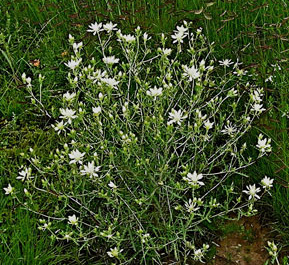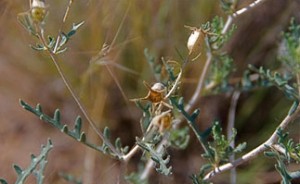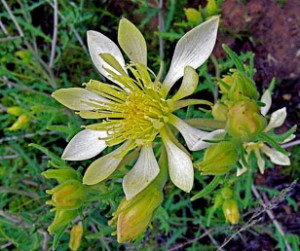Scientific Name: Mentzelia multiflora
Plant Family: Loasaceae – Blazing star
Common Names: Adonis blazing star, Buena mujer
Photos and Text By Janice Tucker

Adonis blazing star (photo credit: Janice Tucker)
One afternoon a few years ago while the Santa Fe Botanical Garden’s Herbarium crew searched for specific plants at Leonora Curtin Wetland Preserve, their attention was drawn to a gorgeous blooming plant. As they neared the plant, they were able to identify it as the Adonis blazing star. What a delightful discovery. The small shrub was profuse with pale yellow to creamy white flowers brilliantly reflecting the afternoon sun like so many, well – blazing stars.
Native to New Mexico and much of the Southwestern United States, this low growing perennial shrub has light-colored branches bearing narrow, bright green leaves with lobed margins. The undersides of the rough leaves are covered with hooked hairs, similar to Velcro. These barbed hairs, combined with a highly viscous sap create a strong adhesive, which will glom onto animal fur, socks or clothing of anything or anyone coming into close contact with it. Spanish-New Mexicans called it pegapega, which clearly defines the plant’s double adherent strength. Translated into English, pegapega means, “It sticks, it sticks.”
The flowers, which open in the afternoon during the months of July and August, are approximately two inches across with ten pale yellow or whitish petals and multiple stamens. They are hermaphrodite (having both male and female organs). The tubular-shaped seed capsules open at the top are surrounded by spikes in a star-shaped pattern and contain many small, winged seeds. These seeds are densely covered with tiny, rounded projections that assist with their dispersal.

Seed pod (photo credit: Janice Tucker)
There are approximately 60 to 70 species in the Mentzelia genus, which was named in honor of Christian Mentzel, a 17th century botanist and physician. The multiflora species describes the many flowers covering the plant during the blooming season.
The Blazing star requires full sun and will not grow in the shade. As long as its roots are in well-drained soil, it is not fussy. It is happy in dry or moist sandy, loamy, heavy clay or ordinary garden soils that are acid, neutral or alkaline. Propagation is by seed, best sown in the spring. Germination should occur in approximately two weeks. There is evidence that cross-pollination can occur when more than one species is in the same area.
The seeds of the Blazing star have been eaten raw or parched and ground into a meal. The leaves and roots were once prepared as a treatment for tuberculosis. It has been used as a diuretic, a laxative and as a pain reliever for rheumatism and toothaches.
Tewa Indians had one of the most interesting uses for the Blazing star. When a young boy was old enough to ride a horse for the first time, the Tewa would rub the leaves of the plant over the boy’s skin. He would then dress and mount the horse. The sticky plant substance was used to help with the boy’s grip and enable him to ride without falling off.

Adonis blazing star ((photo credit: Janice Tucker)
The common name of Buena mujer (a good woman) comes from Spanish New Mexicans. At the risk of being a bit politically incorrect, the implication in this instance refers to the plant’s stickiness and means, “a good woman sticks to a man with such constancy.” Other traditional and medicinal uses for this plant can be found in the delightful book, Healing Herbs of the Upper Rio Grande – Traditional Medicine of the Southwest by Leonora Scott Muse Curtin.
The Adonis blazing star grows in the dry life zones on the south and north sides at Santa Fe Botanical Garden’s Leonora Curtin Wetland Preserve. Afternoon visitors to the Preserve cannot miss this plant if it is in full bloom. Its leaves may grab onto nearby surfaces but the flowers will grab attention by their sheer, far-reaching brilliance, beckoning one to come closer.


